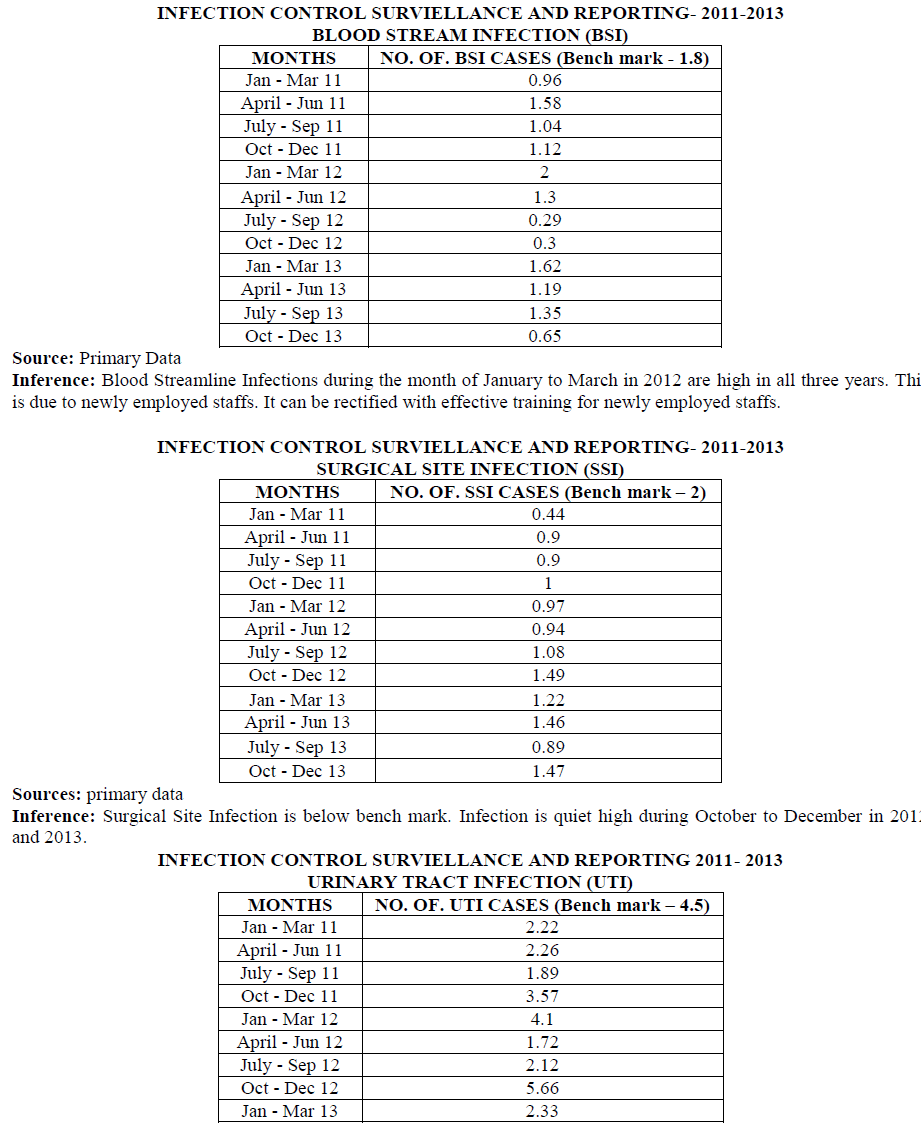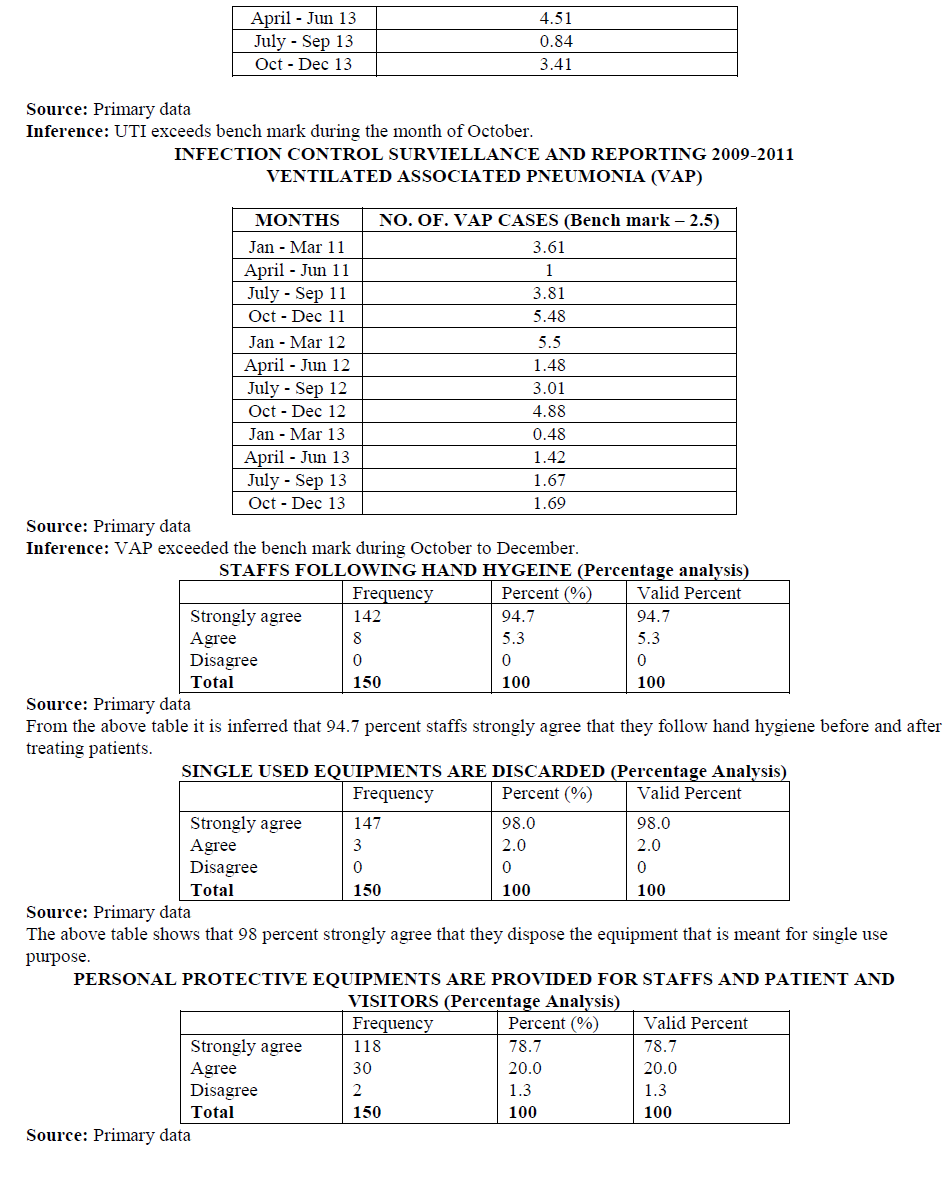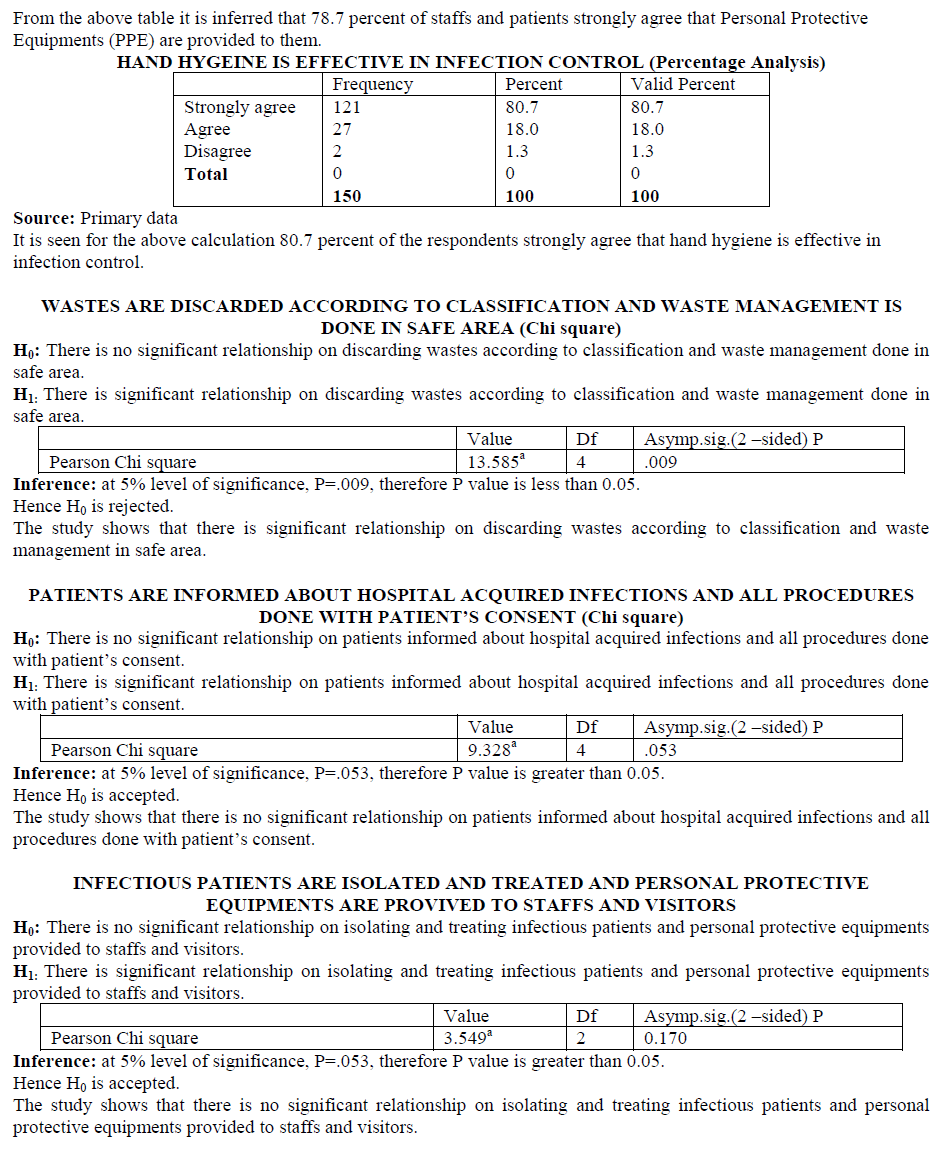ISSN ONLINE(2319-8753)PRINT(2347-6710)
ISSN ONLINE(2319-8753)PRINT(2347-6710)
Dhyana Sharon Ross1, Dr. S. Vasantha2
|
| Related article at Pubmed, Scholar Google |
Visit for more related articles at International Journal of Innovative Research in Science, Engineering and Technology
This prevalence of hospital acquired infections (HAI), commonly called as nosocomial infection in medical terms still exists in major well developed hospitals in many countries. The aim is to check for the level of hospital acquired infection and their level, steps taken to control and effective management of the same. Using standard protocol 100 staffs and 50 patients were taken for the study. Only intensive care units (ICU) patients were taken for study since the rate of infection is very high among these patients. Questionnaires were distributed to collect data and thorough observation was done throughout the hospital on what steps and procedures they are following for the prevention of hospital acquired infection. Study revealed that even though they strictly stick to the Standard Operating Procedures (SOPs), the level of hospital acquired infection sometimes exceeds the benchmark
Keywords |
| HAI, Nosocomial infection, SSI, BSI, UTI, VAP, Infection control. |
INTRODUCTION |
| “Hospital is the place for cure” – this comes to our mind when we think about the hospital. Treating the patients under same roof was considered as a revolutionary idea, and was expected that it will ease the job of healing. But it turned wrong in Pre- Listerian era because of lack of knowledge on sterilization and antisepsis. Gangrene and death were almost mandatory for the patients suffering from wounds. This lead into development of new discipline called as senics which was dealing with the nosocomial infections (Hospital– acquired infections). In 1861, Semmelwis observed the association of Puerperal sepsis with the attendants on patients by medical officers and students and he was successful to bring a dramatic reduction in infection rate by the introduction of hand washing with chlorinated lime. Hospital acquired infections also called nosocomial infections are defined as infections developing in the patients after admission to hospital, which were neither present nor in incubation at the time of hospitalization. Such infections may manifest during their stay in hospital or, sometimes, after the patient is discharged. Patient in hospital are likely to get sick due to a new variety of microorganisms responsible for wide spectrum of hospital infection. So, hospital has increasingly become unsafe place for patient during their stay. Infection is a health hazard of great expense and significance affecting the final outcome of treatment. Infection control (IC) is a quality standard and is essential for the well being and safety of patients, staff and visitors. It affects most departments of the hospital and involves issues of quality, risk management, clinical governance and health and safety. |
II. OBJECTIVES |
| To examine whether nosocomial infection is under control. To check whether BSI, SSI, UTI and VAP are below bench mark. To provide suggestions to keep HAI under control. |
Common hospital acquired infection: |
| 1. Blood Streamline Infections (BSI) 2. Surgical Site Infections (SSI) 3. Urinary Tract Infections (UTI) 4. Ventilated Associated Pneumonia (VAP) |
III. REVIEW OF LITERATURE |
| Deoine Reed, PhD and Sandra A. Kemmerly, MD in 1980: A Study on the Efficacy of Nosocomial Infection Control (SENIC) conducted in the 1980s evaluated the nosocomial infection prevention and control programs in the United States. The SENIC project „bottom line‟ was that 32% of infections that would have occurred in the absence of well-organized infection surveillance and control programs were potentially preventable. In 1999, Dancer depicts that many microorganisms associated with hospital-acquired infections display two particular features; firstly, they are pathogens of well established medical importance and secondly, they can withstand the rigorous of the hospital environment .It benefits them to survive outside temperature human tissues because an appropriate environment niche will provide shelter until some timely mechanisms facilitates their transfer back to patients. Not all of them demonstrate this capacity; some originate from the patient‟s own flora, especially those who are immunocompromised and others can survive only in human tissues and thus rely upon person-to-to person spread in order to disseminate. According to Baveja in 2002, the term hospital acquired infection, hospital– associated infection, hospital infection or nosocomial infection(nosocomion,meaning hospital) is defined as infection developing in patients after admission to the hospital ,which was neither present nor in the incubation period at the time of hospitalization . Such infections may become evident during their stay in the hospital or sometimes after their discharge. Weinstein in 2006 said that nosocomial infections typically affect patients, who are immunocompromised because of age, underlying diseases, or medical or surgical treatment. Nosocomial infection rates in adult and pediatric ICU are approximately three times higher than elsewhere in hospitals. The site of infection and the pathogens involved are directly related to treatment in ICUs. As per Weber and researchers in 2006 the patients hospitalized in ICUs are 5 to 10 times more likely to acquire nosocomial infections than other hospital patients. The frequency of infections at different anatomic sites and the risk of infection varies by infection site. Contributing to the seriousness of nosocomial infections, especially in ICUs, is the increasing incidence of infections caused by antibiotic-resistant pathogens. According to Gupte in 2006, sources of hospital acquired infection are infecting microorganisms from fellow patients which may be multidrug resistant, infecting organisms from hospital staff, infecting organisms from instrument, blood products, intravenous fluid, from patient‟s normal flora, etc, insects are also source multidrug infection, organism may be present in air, dust, water, antiseptic solution, food, surfaces contaminated by patient‟s secretions, blood fluid, etc. |
IV. METHODOLOGY |
| Research Design: The research design used in this study is descriptive and analytical in nature Sampling Design: Cluster Sampling Sample Size: 150 Nature of respondents: Nurses, Hospital administrators and Patients Data Collection: Primary data was collected from nurses, hospital administrators and patients of the hospitals. Secondary data was collected from hospital records, articles and journals. Tools and techniques: Percentage analysis, Chi Square. |
V. STANDARD PROCEDURES OR STANDARD OPERATING PROCEDURES (SOPs) |
| 1. The organization should have a well designed, comprehensive and coordinated infection control programme aimed at reducing / eliminating risks to patients, visitors and providers of care. 2. The organization must have infection control manual, which should be periodically updated. 3. The infection control team is responsible for surveillance activities in identified areas of the hospital. 4. The organization should take actions to prevent, reduce the risk of Hospital Acquired Infections (HAI) in patients and employees. 5. Proper facilities and adequate resources are to be provided to support the infection control programme. 6. The organization must take appropriate actions to control outbreaks of infections. 7. There should be documented procedures for sterilization activities in the organization. 8. Statutory provisions with regard to Bio Medical Wastes (BMW) should be complied with. 9. The infection control programme has to be supported by the organization‟s management and should train staffs of employee health. |
VI. DATA ANALYSIS |
 |
 |
 |
VII. OBSERVATIONS AND FINDINGS |
HOSPITAL INFECTION CONTROL |
| 1. The organization has a well-designed, comprensive and coordinated infection control programme aimed at reducing/eliminating risks to patients, visitors and providers of care: a) Currently there is a working committee on infection control. They meet once in two months. This meeting can be made once in a month so that measures on infection controls can be made effective. b) There is a documented infection control programme. c) There is an infection control team. They are involved in surveillance activities. d) There is designated infection control nurse. |
| 2. The organization has a infection control manual which is periodically updated: a) There is infection control manual. It has all policies and procedures related to infection control activities in the hospital and identify high risk areas in the same. b) Even though surveillance activities like swab culture is done in various areas like OT & ICU there is a need of strengthening the surveillance activities by including rounds, air and water quality checks in high risk areas like CSSD & kitchen. So there must be policies and procedures on surveillance activities in the hospital. c) Policies and procedures related to CSSD activities must be prepared and included in the manual. d) Policies and procedures on engineering controls to prevent infection are not documented. |
| 3. The infection control team is responsible for surveillance activities in identified areas of the hospital a) There is data collected on surveillance activities. The infection control nurse maintains the surveillance data on infection control. b) This is being uniformly done. c) Information is sent to appropriate authorities. d) Monitoring the effectiveness of housekeeping services (infection control) is being done. |
| 4. The organization takes actions to prevent reduce the risk of Hospital Acquired Infections (HAI) in patients and employees a) The infection control nurse collects the data and monitors the rate. b) It is suggested to provide the feedback regarding rates to medical and nursing staffs (can be through circulars, newsletters etc) |
| 4. The organization takes actions to prevent reduce the risk of Hospital Acquired Infections (HAI) in patients and employees a) The infection control nurse collects the data and monitors the rate. b) It is suggested to provide the feedback regarding rates to medical and nursing staffs (can be through circulars, newsletters etc) |
| 6. The organization takes appropriate actions to control outbreaks of infections a) Hospital has documented procedures on handling such outbreaks. It is prepared and implemented. |
| 7. There are documented procedures for sterilization activities in the organization a) There is an established documented procedure. |
| 8. Statutory provisions with regard to Bio Medical Wastes (BMW) are complied with a) The hospital is authorized by GJ for management and handling of bio-medical waste. b) Biomedical waste segregation is done at the source unlike in OT. The color codes and instructions are properly displayed in waste segregation areas. This is displayed uniformly throughout the hospital. c) The waste is cleared at least twice in a day. Trolleys are used with covered bins of different color to transport waste. Also the staffs are trained to use protective measures. d) All the wastes must be weighed before handling over to the outsourcing service. e) Bio-medical waste treatment is outsourced which is authorized to treat biomedical waste. |
9. The infection control programme is supported by the organisation’s management and includes training of staffs and employee health a) Designated infection control nurse is there. b) Facilities like gloves, mask etc is available. c) Elbow taps are provided in patient care services. d) Soap solutions are provided in all hand washing areas instead of soap e) There should be initial orientation for new staffs on infection control f) Proper system of pre and post exposure prophylaxis is implemented throughout the organization. This must be applicable to all staffs working in the organization including outsourced services. |
VIII. SUGESSTIONS AND RECOMMENDATION |
| The existing system of Infection Control measures in this Hospital, has been in practice for over a long period of time. There is only one infection control nurse. Employing two more nurses for infection control team will minimize the work load of IC nurse, so that work is made effective. There is infection control manual. It has all policies and procedures related to infection control activities in the hospital and identify high risk areas in the same. Quality check in air and water should be done regularly. Water sample should be sent for lab to check the presence of micro organisms. Policies and procedures related to CSSD activities must be prepared and included in the manual. Policies and procedures on engineering controls to prevent infection should also be added. The infection control nurse maintains the surveillance data on infection control. Each ward in-charge should also maintain the same. It is suggested to provide the feedback regarding rates to medical and nursing staffs (can be through circulars, newsletters etc) Hand washing should be monitored regularly. Experienced and well trained staffs only should be allowed to treat “ISOLATED” patients. Adequate gloves, masks and disinfectants are available. The usage must be monitored by infection control team. Regular validation tests on validation carried out should be reported to the Infection Control Team regularly. Employees should be well educated about color codes so that waste segregation is done correctly. All the wastes must be weighed before handling over to the outsourcing service. Outsourcing staffs should also be educated about infection control so that development of infection can be minimized to the least. There should be initial orientation for new staffs on infection control Training and educating newly recruited staffs will minimize infections in and around hospital. |
IX. CONCLUSION |
| The study revealed that current physical facilities available for infection control are good and meets the ISO standard level. If the measures followed are continuously updated and upgraded the infection level can be further reduced. This can be done by giving training awareness Training Programme on Standard Requirements, guidance on implementation of infection control programmes. The awareness about infection control should also be developed among visitors. The awareness about the infection has to be created that will help in decrease of infections and control of the same. |
References |
|